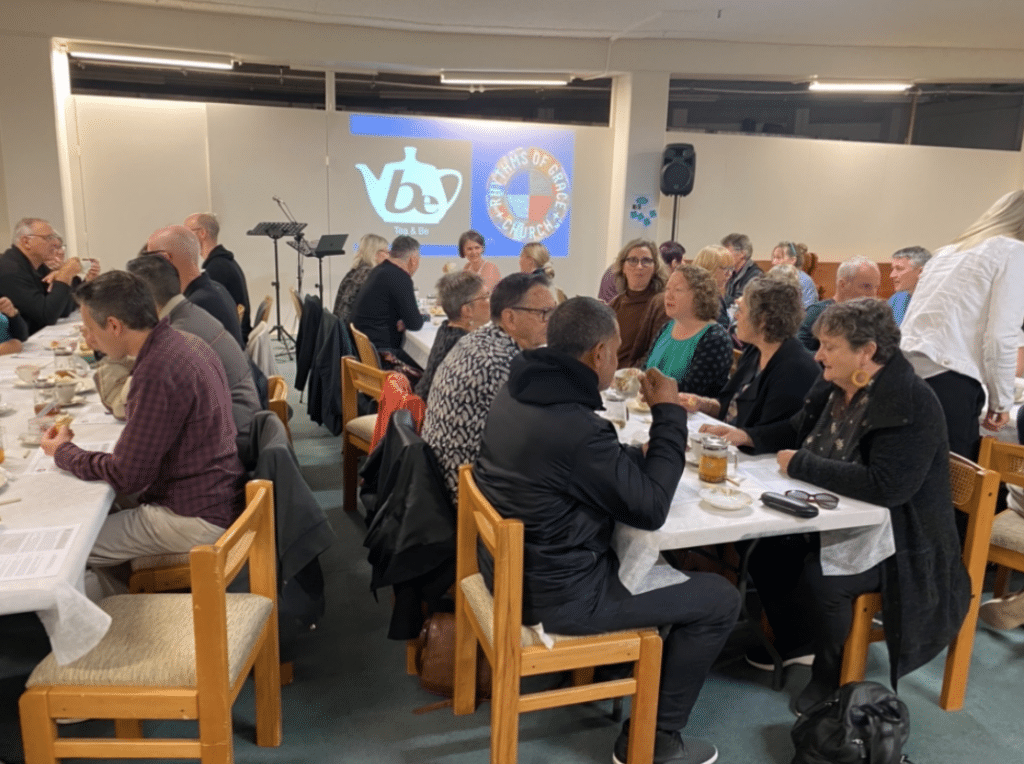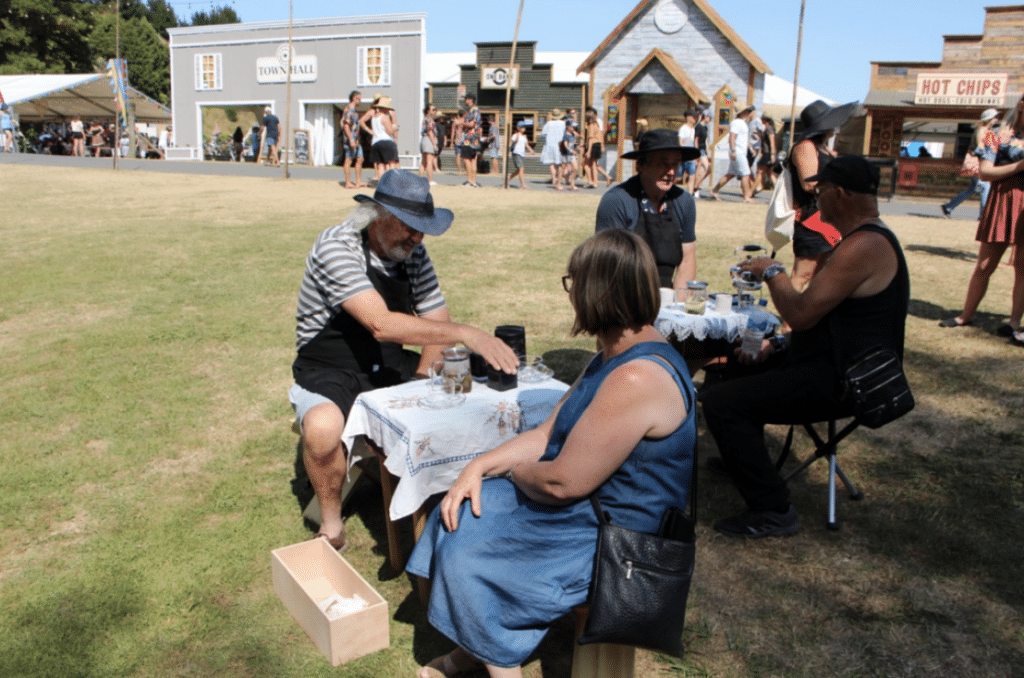Mark Pierson
Lead Pastor & Curator, Rhythms of Grace Church
mark@markpierson.org.nz
Introduction
Since January 2019, I have been developing the practice of curating ephemeral built environments as sacred space, utilizing custom-built pop-up architecture. The purpose of these spaces is to house curated informal tea rituals for two to 80 people. The rituals—called “Tea & Be”—provide a low-key unthreatening reason for entering into conversation and connecting with strangers, that has the potential to sustain participant flourishing and wellbeing as human beings.
Initially these site-specific structures popped-up at Christian arts and music festivals in New Zealand. They have spread to church services, homes, gardens, halls and parks in New Zealand, Australia, United Kingdom, Italy, the USA, and soon to be, Poland. During pandemic lockdowns they moved to Zoom, allowing for, albeit limited, interaction and connection.
The ritual takes place in a curated physical setting established according to the location. A single long table includes individual placemats with a description of the teas on offer, and some conversation starter questions; a shared-between-two glass teapot and bone-china cup & saucer. The ritual itself includes an introduction to the history of tea, explanation of the teas on offer, proper brewing and drinking techniques, and an extended time of conversation and swapping of teas among participants.
In a Christian church service these elements are framed within the elements of worship.

Figure 1: Tea & Be, The Hope Precinct, Festival One, 2020 (Photo credit: Mark Pierson)
Why Tea?
Okakura Kakuso said in his late 19th century readings of “The Book of Tea”1 in the salons of New York City high society, “tea has not the arrogance of wine, the self-consciousness of coffee, nor the simpering innocence of cocoa.” In my experience tea has humility and is an ideal beverage to commune around, even for hardened coffee drinkers.
The making of a cup of tea lends itself to a more communal ritual with observation and participation in a way that other beverages don’t. The drinking of a cup of tea, while retaining many significant health benefits, is less perfunctory and less performance oriented than consuming coffee has become.
Tea is storied. Its flavor is affected by a multitude of environmental factors—the terroir—in the same way wine is, as well as an equally broad range of factors relating to what and when it is picked, how it is processed, how the tea drinker makes it, and finally how it is drunk. All teas come from the same bush—camellia sinensis. So the story of how these factors produce one of more than 1500 different teas adds to the mystery and art of “the way of tea”—chanoyuor sadoin Japanese.

Figure 2: Tea & Be, Rhythms of Grace Church Meeting, 2019 (Photo credit: Mark Pierson)
The history of tea drinking in both Japan and China is infused with spiritual and religious meaning that goes back many centuries. The architecture of teahouses reflects this. The growing, processing, and slow contemplative ritualized making, and drinking of tea connect us to each other, to the past, to ourselves, and to our God.
What About the “Be”?
Contemporary Western culture runs at hyper-speed. Uncertainty about everything we previously took for granted, and the future, have been heightened by the Covid-19 pandemic, resulting in a pandemic of anxiety, disconnection, and fear of the other.
Japan’s Sen no Rikyu2 held the philosophy that every Japanese tea gathering should be treasured because the moments can never be fully recaptured. He developed principles that he said must be incorporated into the tea ceremony and its buildings: harmony, respect, purity, and tranquillity—values increasingly rare in Western culture. While not attempting to follow a formal Japanese tea ceremony, or architecture of the spaces housing the ritual, Tea & Be keeps Rikyu’s values and those of wabi-sabi (“the beauty of imperfect things.”) 3 in mind.
The name “Tea & Be” combines the key elements of “tea” and of “be”—to “have a cuppa” (cup of tea) in the New Zealand and English vernacular, and to “be”—to be present to ourself, the other and to God. To ‘Be” in the moment.
Connection
The loss of meaningful connection with others is one of the key breakdowns in society.4
Tea & Be seeks to provide opportunities for strangers to connect in safe, non-threatening ways through the device of a guided tea-ritual. While the wider architectural environment is less important than the architecture of the table and what happens on and around it, transitional space between the two is important. Significant work and care goes into curating an architecture that will engage all the senses and allow for “being”—a focus on the present moment without distraction.
Responses
At a three-day festival twenty-one Tea & Be sessions were offered and the 300 seats signed up for on the first day. Written feedback was universally positive.
Development
I have developed a Tea & Be Communion event that uses a tea ritual as the foundation for Communion/Eucharist. This liturgy is offered in-person and online to groups and individuals. (The 17th and 18th century banning of Christianity in Japan saw Christians using the tea ceremony as their Communion in order to not be further persecuted.)
I founded the International Guild of Tea Liturgists with patron saint Francis Xavier of Goa, to gather friends around the world who were inspired to use similar tea rituals to bring people together5.
The smallest pop-up is for a one-on-one sidewalk or woodland tea communion. It’s a suitcase- that-becomes-a-table. This mobile unit contains all the elements needed for a Tea & Be.

Figure 3: Tea & Be in a suitcase, Festival One, 2019 (Photo credit: Mark Pierson)
Karakia (Prayer) for Tea
As the cup holds the water so we hold your presence, O God.
As the water draws the flavour so your Spirit draws your life through us.
As the tea simply rests to fulfil its purpose may we be at rest as we drink,
And so move closer to being who you made us to be. Amen.6

Figure 4: Tea & Be, Shalom Precinct, Festival One, 2019 (Photo credit: Mark Pierson)
1 Okakuro Kakuzo, The Book of Tea: A Japanese Harmony of Art, Culture, and the Simple Life (1906)
(North Clarendon: Tuttle Publishing, 1956)
2 https://en.wikipedia.org/wiki/Sen_no_Rikyū, accessed 31 April, 2023
3 https://en.wikipedia.org/wiki/Wabi-sabi, accessed 31 April, 2023
4 Johann Hari, Lost Connections: uncovering the real causes of depression – and the unexpected solutions,(New York:Bloomsbury Circus, 2018) p72f
5 https://markpierson.org.nz/2019/12/launch-of-the-international-guild-of-tea-liturgists/, accessed 31 April, 2023
6 Mark Pierson, Prayer for Tea, 2019 (Author’s own.)



